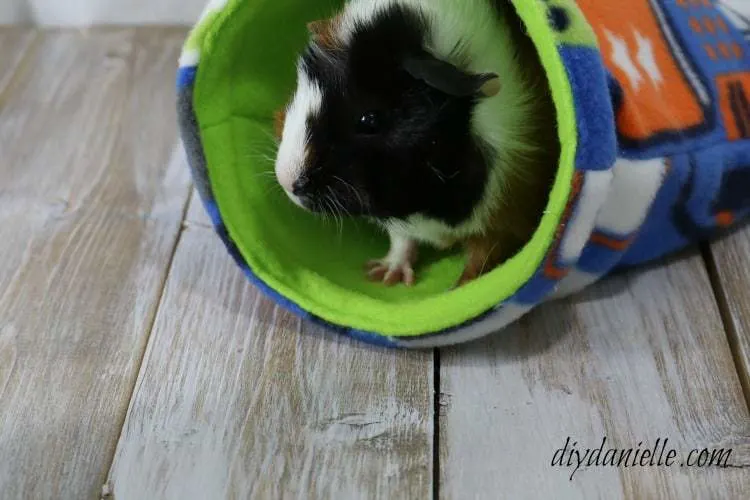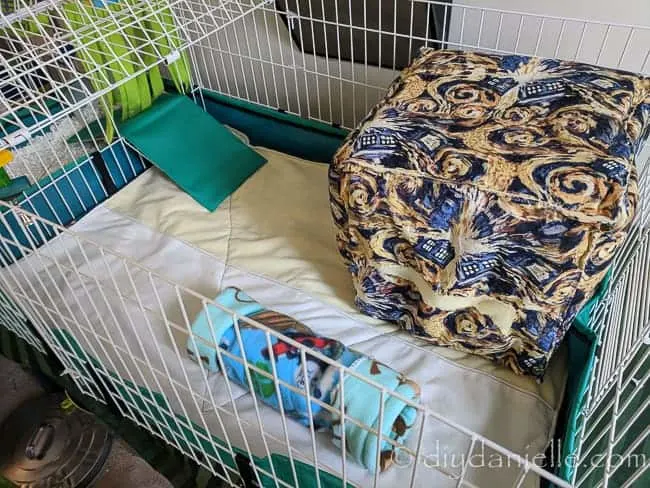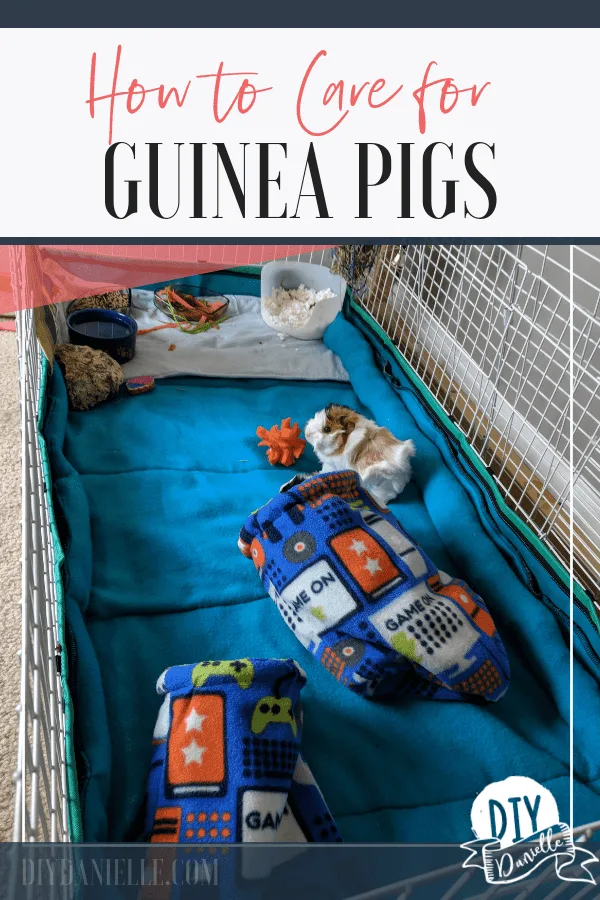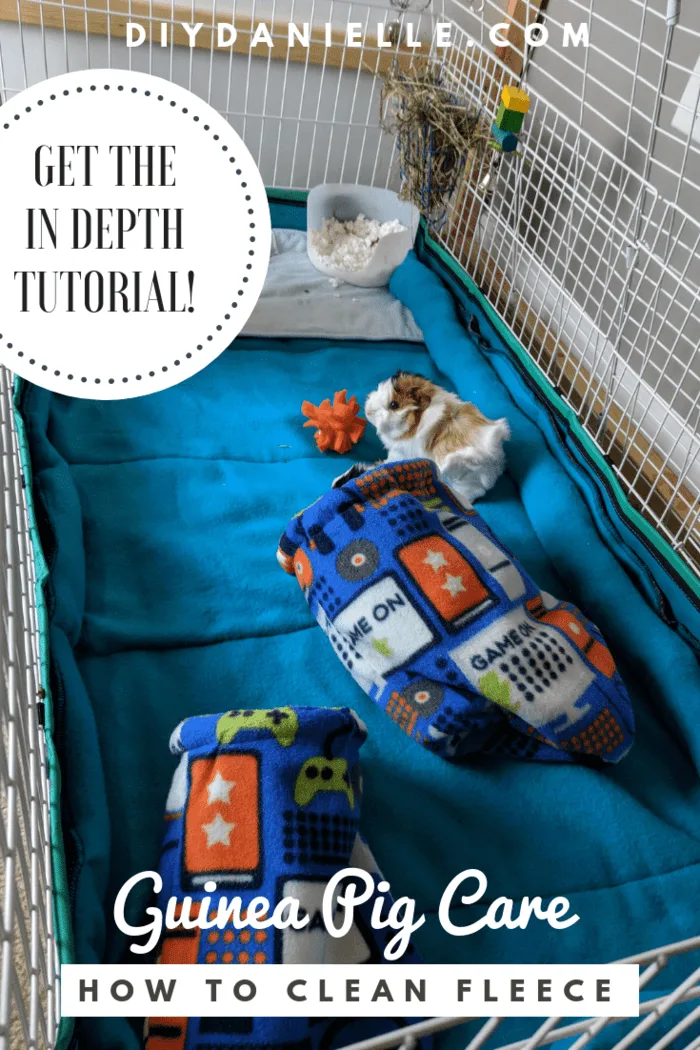
Tips for guinea pig care. Learn how to clean a guinea pig cage, what guinea pigs can eat, and how to bond with them so your guinea pigs are healthy and happy.
This post contains affiliate links. If you make a purchase with these links, I may receive a commission. This does not affect the price of your purchase. Thank you.
Guinea pigs make such great pets for adults and children. They’re friendly, larger than smaller pets like gerbils or hamsters, and super entertaining to watch. They’ve got a lot of personality. They are, however, not as simple to take care of as you might believe. Often pet stores let people go home with a guinea pig without giving them the necessary information to care for their cavy. Not caring properly for your guinea pigs will lead to health issues down the road. Avoid those health issues by learning proper guinea pig care.
Full disclosure- my whole goal while owning pets is to avoid trips to the vet so I go nuts trying to keep them safe. While some of these tips may seem a bit extreme, I just would rather spend a few more minutes on pet care than hundreds of dollars in vet bills.
This is going to be a basic guide to caring for your guinea pig. I recommend the book, Guinea Pigs (Complete Pet Owners Manual), which you can buy on Amazon.
You can also check out my favorite guinea pig products on Amazon.
Guinea Pig Care
Selecting a Guinea Pig
Guinea pigs should not be an impulse purchase. Do your research and find a quality pet store to purchase your guinea pig, or adopt from a guinea pig rescue (or a regular rescue).
You need at least two guinea pigs. They are herd animals and aren’t happy as a solo pet. This is a big deal because there are certain factors you need to take into consideration when buying two guinea pigs.
First– Bonding two guinea pigs isn’t necessarily easy. So if you purchase a guinea pig from one store and another from another, there’s a process to go through to introduce them. From what I understand, bonding two males is more difficult than two females. Personally, I think it’s convenient to buy or adopt a pair that have already bonded (ie. mine are litter mates).
Second– You DO NOT WANT TO GET A MALE AND A FEMALE. They WILL breed unless they’re a bonded pair that has been fixed. Generally this wouldn’t be recommended because the operation is risky on such a small animal, but some rescues do ‘fix’ their guinea pigs.
The problem is that many pet stores make guesses on the genders of their guinea pigs and aren’t good at it. You might come home with ‘two females’ just to wake up one day with a litter of guinea pigs. And the crazy part is that guinea pigs can get pregnant IMMEDIATELY after child birth so… yeah.
I found my guinea pigs at a store I KNEW was very educated about pet care. I felt like they’d be more likely to have the pets sexed correctly and have healthy animals. Not all pet stores do this. Many people come home with pets that are already sick from big name stores.
When you’re looking at the animals at the store, make sure NONE of the animals look sick. If one looks sick, you shouldn’t purchase any animal from that store. This is just my personal opinion. Vet care is very expensive and a lot of illnesses are contagious and can spread between animals. Now… a sick fish is probably not spreading something to a guinea pig, but the hamster next door? Yeah.
Look at the animal’s whole body- Are their eyes dripping? Are their nails over grown? Are they listless or active? Are they coughing or sneezing?
Guinea pigs are nervous by nature so that’s just par for the course. Ours give us a chase to pick them up but sit happily in our hands while we’re holding them. So don’t worry so much about that aspect, although finding an animal who is comfortable but still lively is good.
Selecting a Cage
Size matters more than anything else. Guinea pigs are larger than a hamster or other small pet, and they need cages that reflect that. Even with a good size cage, they still need free time to run around. Here’s the cage sizes that the ASPCA recommends. This Midwest cage is 8 sq ft and works for two guinea pigs, although I’d like to eventually expand it. There’s more to the cage than you can see in the picture below.

I was loving on a lot of multilevel cages made from furniture for a while, but apparently lots of ramps aren’t great for guinea pigs. They can fall over the edge and get injured, and they aren’t exactly a climbing animal. So some ramp is fine, but make sure that it’s not a cage with all vertical space. They need room to run.
Wire bottoms to cages aren’t good for their feet. This can give them injuries.
Make sure your cage has a top if you have to worry about children or other pets getting into the cage.
I love the Midwest cage, but I recently built a base to go under it because the bottom is completely soft. The base is on wheels and works really well for moving the cage so I can vacuum under it.
The cage needs to be kept somewhere that isn’t too hot or too cold. I put ours in the boys’ room because we hold them every night at reading time. I also liked the temperature and location for the cage there. My only suggestion would be to KNOW YOUR CHILD. If you think your child can’t be left unsupervised with the guinea pigs, don’t put them in their room. I don’t 100% trust my middle son still and supervise.
Here’s an article I wrote about options for guinea pig cages, and I recently saw these pretty neat plastic cages that look easy to clean that are made by Eglu. I think they could be used indoors if you used chloroplast and/or soft cage liners on the bottom of the cage run.
How to Clean a Guinea Pig Cage
Keeping your guinea pigs cage clean is important for the health of your guinea pig and also to keep your house clean. You can use paper bedding or fleece bedding. We use fleece bedding and have a litter box with paper bedding that is placed under their hay bag. This is the area that gets ‘used’ most often to potty so I am able to easily dump the litter box every 1-2 days. Then I can clean the fleece as it gets soiled.
I’m going to give you information on how I clean our guinea pig cage with fleece and paper bedding for the litter box. If you plan to exclusively use paper bedding, I’m probably no help. I have only done it once or twice, but they kick the bedding out and it drives me nuts to clean up. Fleece is much nicer in my opinion.
Here’s a video with an explanation of how I clean my guinea pig cage…
Step 1: Remove all extra items, feed containers, and toys.
Step 2: Remove the litter box and empty it into your bin. Wash it out and dry it if necessary. Refill with paper bedding. You could possibly put a little baking soda on the bottom, but I haven’t researched if it’s safe. Place to side.
Step 3: Remove your fleece liners. You need to empty the poop, hay and bedding into your bin. I use a brush to brush the poop and hay into my bin, or you could shake it outside. A small shop vac is also an option if you want to vacuum it out. Sometimes I brush it all into the cage, then use a shop vac or my brush/pan to sweep it all up. You want to make sure you clean them off completely because poop will stay in your washer if you put it through the wash. Hay also will stay in your washer.
Step 4: If there are any dirty spots on the bottom of your cage, use a wipe with a vinegar/water solution to wipe the bottom of your cage clean. Bleach doesn’t play nice with ammonia so I don’t recommend it, but feel free to check with your vet if there’s any concerns about sanitizing your cage.
Step 5: Add clean fleece pads to your cage. Return all items, cleaned, to the cage. Add clean water, food, and hay.
Dirty fleece can be kept in a wet bag until wash day.
What to Feed Your Guinea Pigs
Guinea pigs need fresh veggies and fruits, a steady supply of hay, and plain pellets made for guinea pigs. Avoid the food that has a mix of other ‘treats’ in it… apparently it’s not as healthy, but the other issue for me was that my guinea pigs wouldn’t eat the ‘extras’ and picked the pellets out only. So it was a waste of money too.
This is a great resource on what fresh veggies and fruits guinea pigs can eat. I recommend printing the list. There’s a limit to which foods they can have and how often- you DO NOT want to overfeed fruits or veggies. They can have health problems. You’ll also find that your cavies have preferences… mine don’t like zucchini and aren’t fans of any fruit, but love green bell peppers and lettuce.
The MOST IMPORTANT FOOD is the hay. They love hay… they love to burrow in it, eat it, and poop in it. Don’t worry, they’ll eat around the soiled pieces. Many people put hay in small paper bags which the guinea pigs love and others use it in their litter box. I made this hay bag which I love because it fits lots of hay and they can snuggle up in there if they want.
They need fresh water daily as well. While a bottle might seem easier, I tend to err on the side of caution and use a water container that gets refilled daily so their water is always fresh. They can and will poop in the water container, but that is just a helpful reminder to change the water. LOL.
How to Bond with Your Guinea Pigs
Hold your guinea pigs daily. We have a routine to doing this. Every night we get our PJs on, brush our teeth, clean the cage, then the kids snuggle up with their guinea pigs to read books for the night. This makes sure the guinea pigs get daily attention. When something is part of the daily routine, kids are less likely to forego doing it and forget about their pet. Just my two cents. I made small snuggle sacks for the boys at first so they could more easily hold the guinea pigs. This allowed them to hold them without squeezing too hard if the guinea pigs tried to get away. It also makes it easier to pick up the guinea pigs because you can herd them into the sack, then pick up the sack. This causes WAY less trauma for the poor cavies who are just generally nervous little critters.
They also love food. You can hand feed them hay or veggies. Just make sure the veggies are safe ones.
Products You Can Get for Your Guinea Pig
They love places to hide (Pigloo/Igloo) and small toys to play with. They love paper towel rolls to chew on. There are some trees that are safe to cut branches from to give them to chew on. They love soft and fuzzy things which is why fleece is such a popular fabric used for guinea pig products.
Do not buy anything they could get stuck in… wire hay racks and the above head wire feeders are apparently major culprits for guinea pig injuries.
Things You Can Make for Your Guinea Pig
- How to Make a Guinea Pig Hay Bag
- How to Make a Litter Box for a Guinea Pig
- How to Make Fleece Cage Liners for Guinea Pigs
- Customized Guinea Pig Igloo
Thanks for reading! Please pin this!


